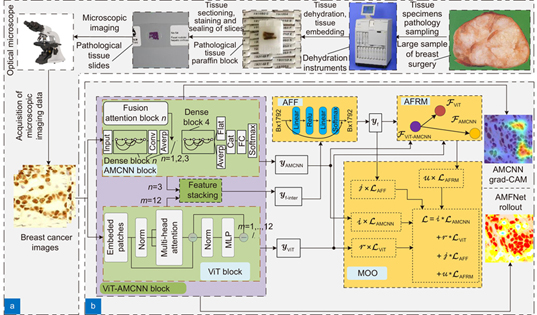[12] BenTaieb A, Hamarneh G. Predicting cancer with a recurrent visual attention model for histopathology images[C]//21st International Conference on Medical Image Computing and Computer Assisted Intervention, 2018: 129–137. https://doi.org/10.1007/978-3-030-00934-2_15.
[18] Abnar S, Zuidema W. Quantifying attention flow in transformers[C]//Proceedings of the 58th Annual Meeting of the Association for Computational Linguistics, 2020: 4190–4197. https://doi.org/10.18653/v1/2020.acl-main.385.
[19] Chefer H, Gur S, Wolf L. Transformer interpretability beyond attention visualization[C]//Proceedings of the IEEE/CVF Conference on Computer Vision and Pattern Recognition, 2021: 782–791. https://doi.org/10.1109/CVPR46437.2021.00084.
[22] Gao Z Y, Hong B Y, Zhang X L, et al. Instance-based vision transformer for subtyping of papillary renal cell carcinoma in histopathological image[C]//24th International Conference on Medical Image Computing and Computer Assisted Intervention, 2021: 299–308. https://doi.org/10.1007/978-3-030-87237-3_29.
[23] Wang X Y, Yang S, Zhang J, et al. TransPath: Transformer-based self-supervised learning for histopathological image classification[C]//24th International Conference on Medical Image Computing and Computer Assisted Intervention, 2021: 186–195. https://doi.org/10.1007/978-3-030-87237-3_18.
[24] Li H, Yang F, Zhao Y, et al. DT-MIL: deformable transformer for multi-instance learning on histopathological image[C]//24th International Conference on Medical Image Computing and Computer Assisted Intervention, 2021: 206–216. https://doi.org/10.1007/978-3-030-87237-3_20.
[26] Zou Y, Chen S N, Sun Q L, et al. DCET-Net: dual-stream convolution expanded transformer for breast cancer histopathological image classification[C]//2021 IEEE International Conference on Bioinformatics and Biomedicine (BIBM), 2021: 1235–1240. https://doi.org/10.1109/BIBM52615.2021.9669903.
[27] Dosovitskiy A, Beyer L, Kolesnikov A, et al. An image is worth 16x16 words: transformers for image recognition at scale[C]//9th International Conference on Learning Representations, 2021.
[29] Schapire R E. The boosting approach to machine learning: an overview[M]//Denison D D, Hansen M H, Holmes C C, et al. Nonlinear Estimation and Classification. New York: Springer, 2003: 149–171. https://doi.org/10.1007/978-0-387-21579-2_9.
[30] Ting K M, Witten I H. Stacking bagged and Dagged models[C]//Proceedings of the Fourteenth International Conference on Machine Learning, 1997: 367–375. https://doi.org/10.5555/645526.657147.
[32] Zhou Z H. Machine Learning[M]. Beijing: Tsinghua University Press, 2016: 171–196.
[33] Selvaraju R R, Cogswell M, Das A, et al. Grad-CAM: visual explanations from deep networks via gradient-based localization[C]//Proceedings of the 2017 IEEE International Conference on Computer Vision, 2017: 618–626.
[34] Selvaraju R R, Cogswell M, Das A, et al. Grad-CAM: visual explanations from deep networks via gradient-based localization[C]//Proceedings of the IEEE International Conference on Computer Vision, 2017: 618–626. https://doi.org/10.1109/ICCV.2017.74.
[36] Szegedy C, Vanhoucke V, Ioffe S, et al. Rethinking the inception architecture for computer vision[C]//2016 IEEE Conference on Computer Vision and Pattern Recognition (CVPR), 2016: 2818–2826. https://doi.org/10.1109/CVPR.2016.308.
[37] Chollet F. Xception: deep learning with depthwise separable convolutions[C]//30th IEEE Conference on Computer Vision and Pattern Recognition, 2017: 1800–1807. https://doi.org/10.1109/CVPR.2017.195.
[38] He K M, Zhang X Y, Ren S Q, et al. Deep residual learning for image recognition[C]//2016 IEEE Conference on Computer Vision and Pattern Recognition, 2016: 770–778. https://doi.org/10.1109/CVPR.2016.90.
[39] Huang G, Liu Z, Van Der Maaten L, et al. Densely connected convolutional networks[C]//Proceedings of the IEEE Conference on Computer Vision and Pattern Recognition, 2017: 2261–2269. https://doi.org/10.1109/CVPR.2017.243.
[40] Wang X L, Girshick R, Gupta A, et al. Non-local neural networks[C]//Proceedings of the IEEE/CVF Conference on Computer Vision and Pattern Recognition, 2018: 7794–7803. https://doi.org/10.1109/CVPR.2018.00813.
[42] Woo S, Park J, Lee J Y, et al. CBAM: convolutional block attention module[C]//Proceedings of the 15th European Conference on Computer Vision, 2018: 3–19. https://doi.org/10.1007/978-3-030-01234-2_1.




